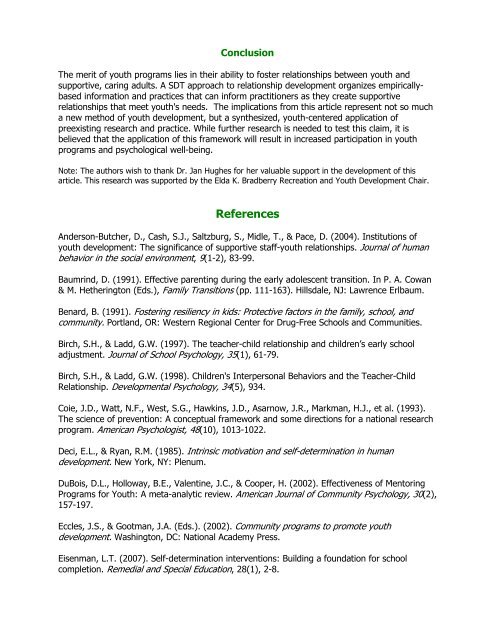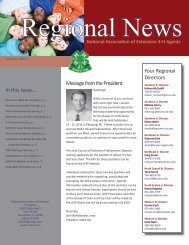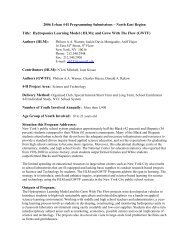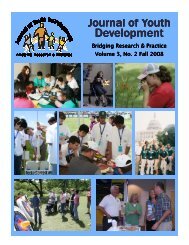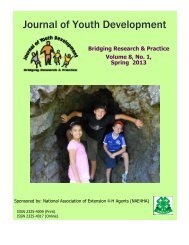likely to internalize the positive values (e.g., goal-directed behavior, persistence, etc.) inherentto competitive sports (Pelletier et al., 2001). Interactions with coaches lead to feelings <strong>of</strong>autonomy when the coach takes the athlete’s perspective, provides choice, reflects the other’sfeelings, and encourages initiative.A competence-supporting environment is one that provides youth with positive feedback ontheir skill development and creates feelings <strong>of</strong> self-efficacy. Such experiences can lead to selfdeterminedmotivation. Eisenman (2007) suggests that there are specific activities that adultscan do to teach students to be self-determined by modeling problem solving, settingperformance goals, monitoring completion <strong>of</strong> tasks, and evaluating products. Contexts thatsupport youth’s needs for competence are those that also have a high quality <strong>of</strong> relatednesswith the adult who appropriately organizes the activity to maximize skill-building, and provideseffective positive feedback.While relatedness is a need that can be met within the provision <strong>of</strong> autonomy and competence,there are some steps that adults can take to meet the need <strong>of</strong> youth to feel related andconnected to others. For example, in a review <strong>of</strong> studies on relationships between teachers andearly adolescents with high-incidence disabilities, Murray (2002) suggested the following forimproving relationships:• Recognize that youth need to feel supported by adults;• Provide students with opportunities to learn positive relationship skills with adults;• Learn more about students’ backgrounds, interests, and communities;• Develop increased awareness <strong>of</strong> classroom interactions; and• Model and expect appropriate behavior.Effective interpersonal behaviors can include talking to a child in a positive tone, giving a childclear directions, listening to a child, and using a child's name when talking to him or her(Paisley, & Ferrari, 2005). Such approaches to building relationships should be tuned to be ageappropriate;for example, teens may find teachers’ frequent use <strong>of</strong> their names to bepatronizing, whereas seven year old children may not.Individual youth characteristics should be considered as well. For example, in groups withstudents who have low-acceptance by peers or are aggressive, social skills traininginterventions can be used to focus on the affective quality <strong>of</strong> teacher-student interactions byincreasing teacher support <strong>of</strong> students through proactive positive comments and gestures(Hughes et al., 2001). Also, Guzick, Dorman, Gr<strong>of</strong>f, Altermatt, and Forsyth (2004) suggest thatfor youth who are low on social liking and social empathy, an appropriate approach by adultswould be to foster good relationships with students by focusing on praise and refraining fromridicule; in other words, being “cultivators rather than weeders,” (p. 367). Youth’s need forrelatedness can be met in contexts that are characterized by caring, interested, and sensitiveadult role models.The interpersonal relationships between youth and adults can serve as opportunities to meetneeds for autonomy, relatedness, and competence. The meeting <strong>of</strong> such needs is integral toyouth development, and can carry over into other parts <strong>of</strong> youth’s lives. While actual interactiontime with adults in youth programs may be small when compared to interactions with adultfamily members and teachers at school, the experience <strong>of</strong> a diverse support system <strong>of</strong> caringadults strengthens youth by providing additional resources that promote their development.
ConclusionThe merit <strong>of</strong> youth programs lies in their ability to foster relationships between youth andsupportive, caring adults. A SDT approach to relationship development organizes empiricallybasedinformation and practices that can inform practitioners as they create supportiverelationships that meet youth's needs. The implications from this article represent not so mucha new method <strong>of</strong> youth development, but a synthesized, youth-centered application <strong>of</strong>preexisting research and practice. While further research is needed to test this claim, it isbelieved that the application <strong>of</strong> this framework will result in increased participation in youthprograms and psychological well-being.<strong>No</strong>te: The authors wish to thank Dr. Jan Hughes for her valuable support in the development <strong>of</strong> thisarticle. This research was supported by the Elda K. Bradberry Recreation and Youth Development Chair.ReferencesAnderson-Butcher, D., Cash, S.J., Saltzburg, S., Midle, T., & Pace, D. (2004). Institutions <strong>of</strong>youth development: The significance <strong>of</strong> supportive staff-youth relationships. Journal <strong>of</strong> humanbehavior in the social environment, 9(1-2), 83-99.Baumrind, D. (1991). Effective parenting during the early adolescent transition. In P. A. Cowan& M. Hetherington (Eds.), Family Transitions (pp. 111-163). Hillsdale, NJ: Lawrence Erlbaum.Benard, B. (1991). Fostering resiliency in kids: Protective factors in the family, school, andcommunity. Portland, OR: Western Regional Center for Drug-Free Schools and Communities.Birch, S.H., & Ladd, G.W. (1997). The teacher-child relationship and children’s early schooladjustment. Journal <strong>of</strong> School Psychology, 35(1), 61-79.Birch, S.H., & Ladd, G.W. (1998). Children's Interpersonal Behaviors and the Teacher-ChildRelationship. Developmental Psychology, 34(5), 934.Coie, J.D., Watt, N.F., West, S.G., Hawkins, J.D., Asarnow, J.R., Markman, H.J., et al. (1993).The science <strong>of</strong> prevention: A conceptual framework and some directions for a national researchprogram. American Psychologist, 48(10), 1013-1022.Deci, E.L., & Ryan, R.M. (1985). Intrinsic motivation and self-determination in humandevelopment. New York, NY: Plenum.DuBois, D.L., Holloway, B.E., Valentine, J.C., & Cooper, H. (2002). Effectiveness <strong>of</strong> MentoringPrograms for Youth: A meta-analytic review. American Journal <strong>of</strong> Community Psychology, 30(2),157-197.Eccles, J.S., & Gootman, J.A. (Eds.). (2002). Community programs to promote youthdevelopment. Washington, DC: <strong>National</strong> Academy Press.Eisenman, L.T. (2007). Self-determination interventions: Building a foundation for schoolcompletion. Remedial and Special Education, 28(1), 2-8.
- Page 2 and 3:
Winter 2008Volume 3 Number 3Editor
- Page 5:
Examining the Potential Unintended
- Page 8 and 9:
centered, multidisciplinary approac
- Page 10 and 11: Volume 3, Number 3, Winter 2008Arti
- Page 12 and 13: fostering skill learning and positi
- Page 14 and 15: Table 1Participation in out-of-scho
- Page 16 and 17: ResultsOur analyses were conducted
- Page 18 and 19: watching TV, playing video games or
- Page 20 and 21: Accordingly, this research augments
- Page 22 and 23: Dotterer, A.M., McHale, S.M., & Cro
- Page 24 and 25: A Descriptive View of the 4-H Club
- Page 26 and 27: In this paper, the results of a cro
- Page 28 and 29: section is a set of statements that
- Page 30 and 31: Table 3Experience in the 4-H clubNo
- Page 32 and 33: significantly higher than Caucasian
- Page 34 and 35: p
- Page 36 and 37: This study focused only on the 4-H
- Page 38 and 39: Theokas, C., Lerner, J.V., Phelps,
- Page 40 and 41: Volume 3, Number 3, Winter 2008Arti
- Page 42 and 43: potential for reaching audiences, d
- Page 44 and 45: Putting Marketing Concepts into Pra
- Page 46 and 47: 2. Find out what others think about
- Page 48 and 49: Diem, K.G. (1994). What do youth li
- Page 50 and 51: Promoting Supportive Relationships
- Page 52 and 53: focused on youth-adult relationship
- Page 54 and 55: Conversely, more modern educational
- Page 56 and 57: perhaps most importantly, the effic
- Page 58 and 59: Organized youth programs, when stru
- Page 62 and 63: Ellis, J.M., & Caldwell, L.L. (2005
- Page 64 and 65: Schweinle, A., Meyer, D.K., & Turne
- Page 66 and 67: Volume 3, Number 3, Winter 2008Arti
- Page 68 and 69: This study uses the “5 Cs” mode
- Page 70 and 71: ResultsIn this analysis 48 codes we
- Page 72 and 73: Table 3Inductive Codes Classified b
- Page 74 and 75: CompetenceCompetence in organized s
- Page 76 and 77: ecause of him (the coach)…. You d
- Page 78 and 79: practices and competitions, the gir
- Page 80 and 81: Eccles, J.S., & Gootmann, J.A. (Eds
- Page 82 and 83: Smoll, F.L., & Smith, R.E. (2002).
- Page 84 and 85: Volume 3, Number 3, Winter 2008Arti
- Page 86 and 87: The present work builds upon that o
- Page 88 and 89: MethodSample and Data CollectionAs
- Page 90 and 91: (scores ranging from 0 to 8) and a
- Page 92 and 93: Table 2Paired Sample T-tests Compar
- Page 94 and 95: Hypotheses 5 and 6 were tested by c
- Page 96 and 97: De Coverly Veale, D.M.W. (1987). Ex
- Page 98 and 99: Story, M., Neumark-Sztainer, D., Sh
- Page 100 and 101: Volume 3, Number 3, Winter 2008Arti
- Page 102 and 103: Cronbach’s Alpha Score For Youth
- Page 104 and 105: 12 to 18 years old. Fourteen of the
- Page 106 and 107: Therefore, there was a mixed relati
- Page 108 and 109: Youth respondents identified two ob
- Page 110 and 111:
are developed through working in a
- Page 112 and 113:
Seevers, B.S., & Dormody, T.J. (199
- Page 114 and 115:
Volume 3, Number 3, Winter 2008Arti
- Page 116 and 117:
With the many opportunities that yo
- Page 118 and 119:
meaningfully reduced involving dedu
- Page 120 and 121:
StaffingXTime/Schedule X X XTrainin
- Page 122 and 123:
“Involving adults that will allow
- Page 124 and 125:
“They can't drive or do not have
- Page 126 and 127:
page in understanding why youth voi
- Page 128 and 129:
Parker, L. (1999). If all youth ser
- Page 130 and 131:
Volume 3, Number 3, Winter 2008Arti
- Page 132 and 133:
However, the literature is mixed in
- Page 134 and 135:
group was the quality of the progra
- Page 136 and 137:
Table 1Reasons for Non-Attendance:
- Page 138 and 139:
easons given was six. Sixty-three p
- Page 140 and 141:
The non-family-related activities t
- Page 142 and 143:
“Catch ‘Em Being Good:”An Ext
- Page 144 and 145:
In 2001, the WVUES received a schoo
- Page 146 and 147:
to leverage the resources of the co
- Page 148 and 149:
4. Most primary behavior incidents
- Page 150 and 151:
Recommendations for developing prog
- Page 152 and 153:
Cross-Cultural UnderstandingThrough
- Page 154 and 155:
that plague these nations such as p
- Page 156 and 157:
2003). Youth leadership training in
- Page 158 and 159:
• enable these young people to pa
- Page 160 and 161:
We believe that the USPORT program
- Page 162 and 163:
West Virginia’s Response to theRo
- Page 164 and 165:
Ensuring good oral health requires
- Page 166 and 167:
Table 1Correlations between Planner
- Page 168 and 169:
problems in this rural state…This
- Page 170 and 171:
Volume 3, Number 3, Winter 2008Arti
- Page 172 and 173:
vacuum. Determination of factors, a
- Page 174 and 175:
ReferencesBaldwin, C., & Caldwell,
- Page 176 and 177:
Volume 3, Number 3, Winter 2008Arti
- Page 178 and 179:
Purpose of StudyThe purpose of this
- Page 180 and 181:
Students in the High computer gamin
- Page 182 and 183:
Do Higher Levels of 4-H LeadershipA
- Page 184 and 185:
IntroductionEmotional Intelligence
- Page 186 and 187:
second section examined demographic
- Page 188 and 189:
a constructive manner. The group is
- Page 190 and 191:
differences in the scores for the 1
- Page 192 and 193:
Adaptability include “Reality Tes
- Page 194 and 195:
ReferencesAmerican Academy of Pedia
- Page 196 and 197:
Healthy Kids, Healthy Families:A Co
- Page 198 and 199:
and a half million U.S. youth (ages
- Page 200 and 201:
Families. In partnering counties, p
- Page 202 and 203:
Healthy Families was then offered a
- Page 204 and 205:
Kamberelis, G., & Dimitriadis, G. (
- Page 206 and 207:
Volume 3, Number 3, Winter 2008Arti
- Page 208 and 209:
Change It Up!What Girls Say About R
- Page 210:
In addition, the study summarizes t


